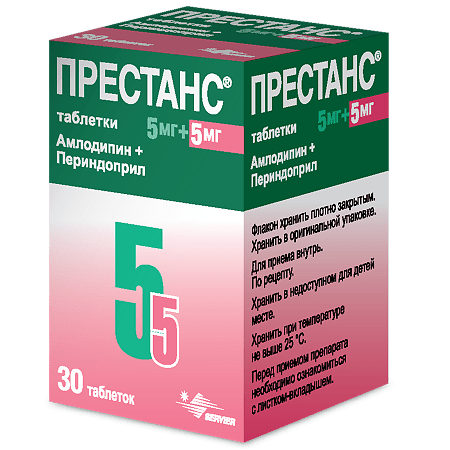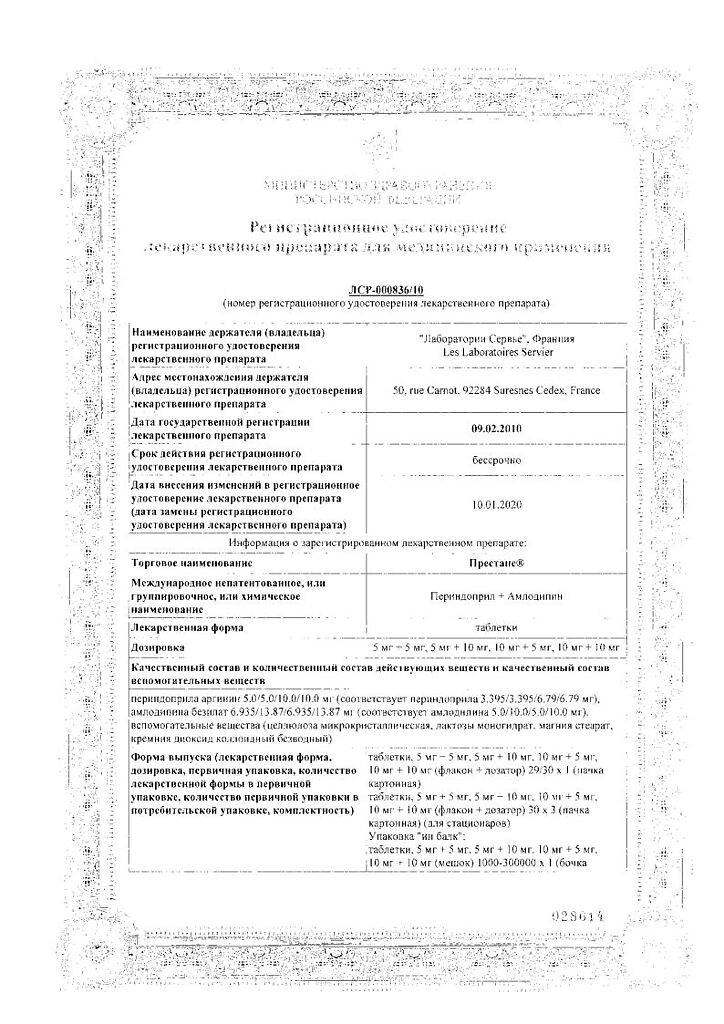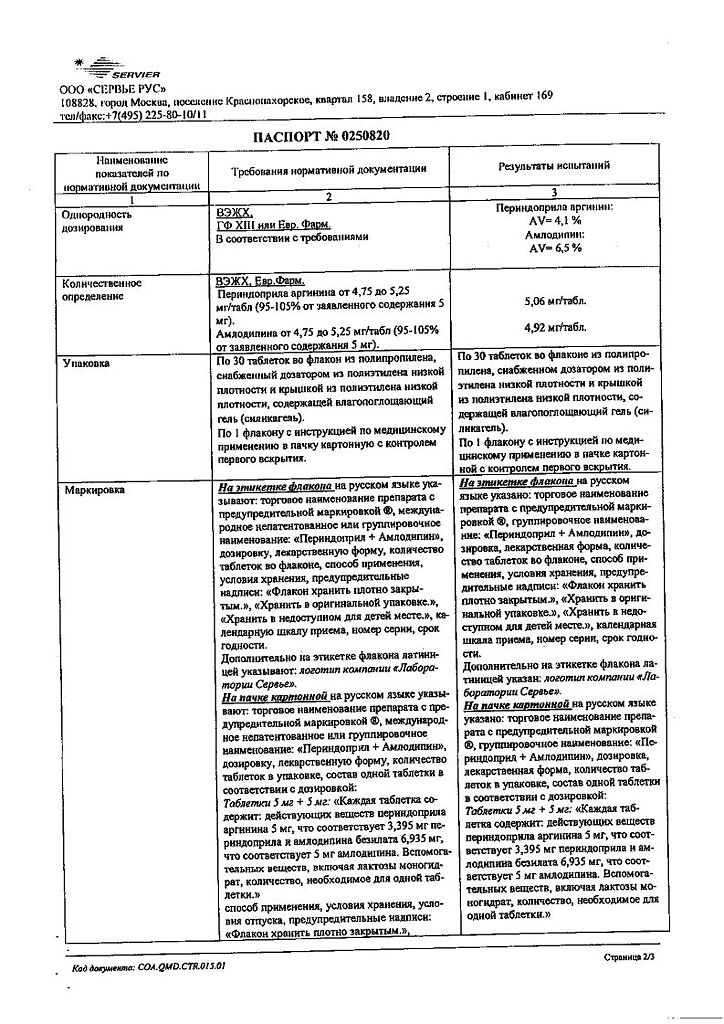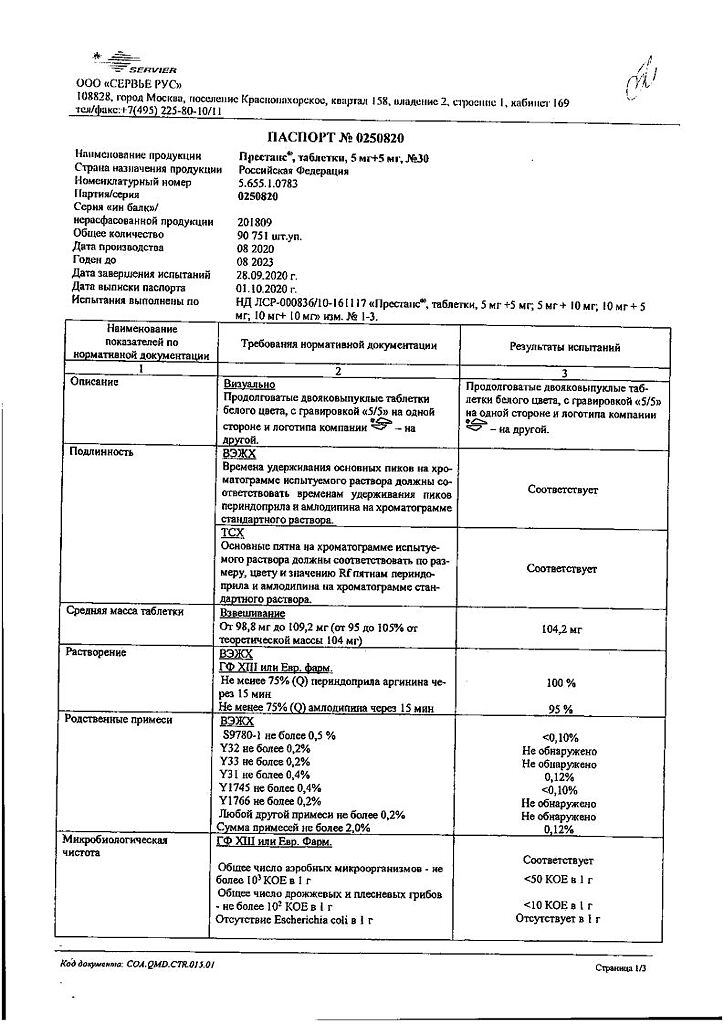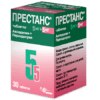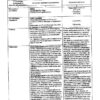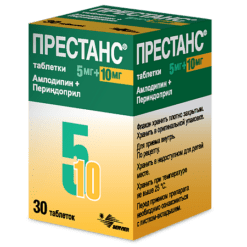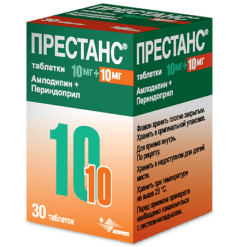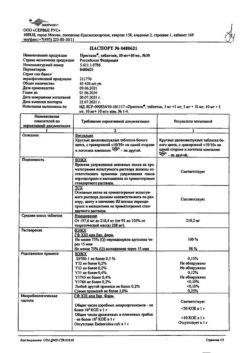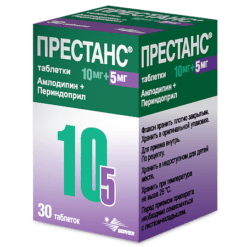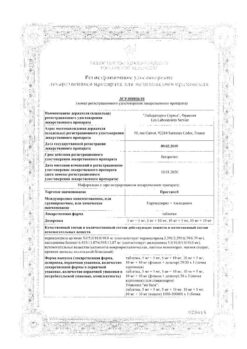No products in the cart.
Prestance, tablets 5 mg+5 mg 30 pcs
€19.71 €16.43
Description
Perindopril is an inhibitor of the enzyme that converts angiotensin I to angiotensin II (ACE inhibitor). Amlodipine is a “slow” calcium channel blocker, a dihydropyridine derivative, inhibits transmembrane transition of calcium ions into cardiomyocytes and smooth muscle cells of the vascular wall.
Indications
Indications
In adults: Arterial hypertension and/or coronary heart disease: stable angina pectoris in patients who require therapy with amlodipine and perindopril.
Pharmacological effect
Pharmacological effect
Perindopril is an inhibitor of the enzyme that converts angiotensin I into angiotensin II (ACE inhibitor). Amlodipine, a blocker of “slow” calcium channels, a dihydropyridine derivative, inhibits the transmembrane transition of calcium ions into cardiomyocytes and smooth muscle cells of the vascular wall.
Special instructions
Special instructions
Hypersensitivity/angioedema. Stop taking the drug and observe the patient until signs of edema disappear completely. Angioedema with laryngeal edema can be fatal. When used together with the combination of valsartan + sacubitril, racecadotril, mTOR inhibitors (for example, sirolimus, everolimus, temsirolimus), gliptins (linagliptin, saxagliptin, sitagliptin, vildagliptin), the risk of angioedema (for example, swelling of the tongue, vocal folds or larynx with or without airway obstruction).
Combined use with drugs containing valsartan + sacubitril. Contraindicated. Use of one drug no earlier than 36 hours after stopping the other.
Anaphylactoid reactions during LDL apheresis. Rarely, life-threatening reactions may occur. Temporarily stop therapy before each procedure.
Anaphylactoid reactions during desensitization. Temporarily discontinue therapy before the procedure. If the drug was accidentally taken, the anaphylactoid reaction occurred again.
Neutropenia/agranulocytosis/thrombocytopenia/anemia. With extreme caution against the background of systemic connective tissue diseases, immunosuppressants, allopurinol or procainamide. Control of leukocytes in the blood.
Renovascular hypertension. Patients with bilateral renal artery stenosis or arterial stenosis of a solitary kidney are at increased risk of severe hypotension and renal failure. Taking diuretics is an additional risk factor. Deterioration of renal function is possible with a slight change in creatinine concentration in patients with unilateral renal artery stenosis.
Double blockade of the RAAS. Concomitant use of ACE inhibitors with ARB II or aliskiren increases the risk of hypotension, hyperkalemia and renal dysfunction (including acute renal failure). Therefore, double blockade of the RAAS is not recommended. The use of ACE inhibitors in combination with ARA II is contraindicated in patients with diabetic nephropathy. Pregnancy. Stop treatment. If necessary, prescribe other antihypertensive therapy.
Primary hyperaldosteronism. Taking drugs whose action is based on RAAS inhibition is not recommended: patients are not susceptible. Arterial hypotension. In patients with an increased risk of developing symptomatic arterial hypotension (with reduced circulating blood volume (BCV), with severe hypertension with high renin activity) and in patients with angina pectoris and cerebrovascular diseases, it is necessary to monitor blood pressure, renal function and K+ content. Transient arterial hypotension is not an obstacle to further taking the drug. After restoration of blood volume and blood pressure, treatment can be continued.
Mitral stenosis/aortic stenosis/hypertrophic cardiomyopathy. With caution.
Heart failure. With caution.
Renal dysfunction. When CC is less than 60 ml/min – individual selection of doses of perindopril and amlodipine and monitoring of K+ and creatinine in the blood serum. In patients with renal artery stenosis, there may be an increase in urea and creatinine in the blood. With renovascular hypertension, there is an increased risk of severe hypotension and renal failure.
Kidney failure. Amlodipine is not eliminated by dialysis.
Liver failure. Rarely, cholestatic jaundice occurs with ACE inhibitors. As it progresses, fulminant liver necrosis develops, sometimes with death. If jaundice or a significant increase in liver enzymes occurs, stop taking the drug. In severe liver failure, increase the dose gradually, ensuring monitoring of the condition.
Ethnic differences. In the Negroid race, perindopril is less effective and the risk of angioedema is higher.
Dry cough. Surgery/anesthesia. Stop treatment the day before surgery.
Hyperkalemia. Regular monitoring of K+ in the blood in patients over 70 years of age, with renal failure, deterioration of renal function, diabetes mellitus, dehydration, acute decompensation of heart failure, metabolic acidosis, combined use of K+-sparing diuretics, K+ salts.
Diabetes mellitus. During the first month, monitor blood glucose.
Heart failure. With caution.
Hypertensive crisis. Efficacy and safety have not been established.
Elderly patients. Increase the dose with caution.
Galactose intolerance, complete lactase deficiency. glucose-galactose malabsorption syndrome. Should not be taken.
MANAGEMENT OF VEHICLES, MECHANISMS. Due to dizziness, drowsiness and other adverse reactions, use caution.
Active ingredient
Active ingredient
Amlodipine, Perindopril
Composition
Composition
Prestan tablets 5 mg/5 mg, 5 mg/10 mg, 10 mg/5 mg, 10 mg/10 mg, containing / amlodipine (AMLO) 5 mg / perindopril arginine (PER) 5 mg, AMLO 5 mg / PER 10 mg, AMLO 10 mg / PER 5 mg, AMLO 10 mg / PER 10 mg. Contains lactose as an excipient.
Pregnancy
Pregnancy
PREGNANCY AND LACTATION. Contraindicated.
FERTILITY. In some patients treated with calcium channel blockers, reversible biochemical changes in the sperm head were found.
Contraindications
Contraindications
hypersensitivity to the active substances, to other ACE inhibitors or other dihydropyridine derivatives, or to any of the excipients listed in the section List of excipients;
history of angioedema (Quincke’s edema) (including while taking other ACE inhibitors);
hereditary/idiopathic angioedema;
pregnancy and breastfeeding (see section Pregnancy and lactation);
combined use with aliskiren and medicinal products containing aliskiren in patients with diabetes mellitus and/or moderate or severe renal impairment (glomerular filtration rate (GFR) <60 ml/min/1.73 m2 body surface area (see Interaction and Pharmacodynamics sections);
combined use with angiotensin II receptor antagonists (ARA II) in patients with diabetic nephropathy (see section Special instructions);
combined use with combination drugs containing valsartan + sacubitril (see sections Special instructions and Interactions);
extracorporeal therapy leading to contact of blood with negatively charged surfaces (see Interaction section); severe bilateral renal artery stenosis or stenosis of the artery of a single functioning kidney (see section Special instructions);
severe arterial hypotension (SBP less than 90 mm Hg);
shock (including cardiogenic);
left ventricular outflow tract obstruction (eg, severe aortic stenosis);
hemodynamically unstable heart failure after acute myocardial infarction;
renal failure (creatinine clearance less than 60 ml/min).
Side Effects
Side Effects
Very common: swelling.
Common: drowsiness, dizziness, headache, dysgeusia, paresthesia, visual impairment (including diplopia), ringing in the ears, vertigo, palpitations, flushing of the face, arterial hypotension, shortness of breath, cough, abdominal pain, nausea, vomiting, dyspepsia, changes in the frequency and nature of stool, diarrhea, constipation, itching, exanthema, skin rash, swelling in the joints (swelling in the ankles), muscle spasms, increased fatigue, asthenia.
Uncommon: rhinitis, eosinophilia, hypersensitivity, hypoglycemia, hyperkalemia, hyponatremia, insomnia, mood lability, depression, sleep disturbance, tremor, hypoesthesia, fainting, tachycardia, arrhythmia (including bradycardia, ventricular tachycardia and atrial fibrillation), vasculitis, bronchospasm, dry mouth, angioedema of the face, extremities, lips, mucous membranes, tongue, vocal folds and/or larynx, alopecia, purpura, skin discoloration, increased sweating, urticaria, photosensitivity reactions, pemphigoid, arthralgia, myalgia, back pain, urinary disorders, nocturia, pollakiuria, renal failure, erectile dysfunction, gynecomastia, peripheral edema, chest pain, pain, malaise, fever, weight gain, weight loss, increased blood urea and creatinine concentrations, fall. Rarely: confusion, exacerbation of psoriasis, increased concentration of bilirubin in the blood, increased activity of liver enzymes.
Very rare: leukopenia/neutropenia, agranulocytosis, pancytopenia, thrombocytopenia, hemolytic anemia in patients with congenital glucose-6-phosphate dehydrogenase deficiency, hyperglycemia, hypertonicity, peripheral neuropathy, stroke, angina pectoris, myocardial infarction, eosinophilic pneumonia, gingival hyperplasia, pancreatitis, gastritis, hepatitis, jaundice, cytolytic or cholestatic hepatitis, increased activity of liver enzymes, angioedema (Quincke’s edema), erythema multiforme, Stevens-Johnson syndrome, exfoliative dermatitis, acute renal failure, decreased hemoglobin and hematocrit.
Unspecified frequency: extrapyramidal disorders, Raynaud’s syndrome, toxic epidermal necrolysis. Syndrome of inappropriate antidiuretic hormone secretion can be considered a very rare complication associated with ACE inhibitors.
Interaction
Interaction
Contraindicated: aliskiren in patients with diabetes mellitus and/or renal impairment. Extracorporeal therapy. Valsartan + sacubitril.
Not recommended: aliskiren: in patients without diabetes or renal impairment; ARA II, estramustine, K+-sparing diuretics (triamterene, amiloride), K+ salts, lithium preparations, dantrolene (intravenous administration), grapefruit or grapefruit juice.
Particular attention: hypoglycemic agents (insulin, sulfonylureas), K+ non-sparing diuretics, K+ sparing diuretics (eplerenone, spironolactone), racecadotril, mTOR inhibitors (sirolimus, everolimus, temsirolimus), non-steroidal anti-inflammatory drugs (NSAIDs), including acetylsalicylic acid ³3 g/day, inducers and inhibitors of CYP3A4, baclofen. Attention: sympathomimetics, gold preparations, tacrolimus, cyclosporine, simvastatin, antihypertensives, vasodilators, corticosteroids, tetracosactide, α-blockers (prazosin, alfuzosin, doxazosin, tamsulosin, terazosin), amifostine, tricyclic antidepressants, antipsychotics, general anesthesia agents.
Medicines that cause hyperkalemia: aliskiren, potassium salts, potassium-sparing diuretics, ACE inhibitors, ARB II, NSAIDs, heparins, immunosuppressants (such as cyclosporine or tacrolimus), trimethoprim and co-trimoxazole (sulfamethoxazole + trimethoprim).
Shelf life
Shelf life
2 years
Manufacturer
Manufacturer
Servier Rus LLC, Russia
Additional information
| Shelf life | 2 years |
|---|---|
| Manufacturer | Servier Rus LLC, Russia |
| Medication form | pills |
| Brand | Servier Rus LLC |
Other forms…
Related products
Buy Prestance, tablets 5 mg+5 mg 30 pcs with delivery to USA, UK, Europe and over 120 other countries.

